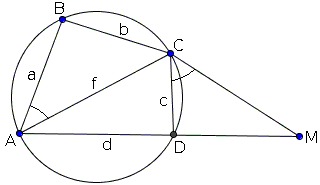Construction of a Cyclic Quadrilateral
Construct a cyclic quadrilateral, given the lengths of its sides in a prescribed order.
Given $4 numbers $a,$ $b,$ $c,$ $d$ which are assumed to be the successive side lengths of a quadrilateral, if one of them is greater than the sum of the remaining three, the construction is rather obviously impossible. There is no quadrilateral whose sides satisfy, say, $a \gt b + c + d.$ Such cases aside, the construction is always possible.
![]()
|Contact| |Front page| |Contents| |Eye opener| |Geometry|
Copyright © 1996-2018 Alexander BogomolnyConstruct a cyclic quadrilateral, given the lengths of its sides in a prescribed order.
Assume the desired cyclic quadrilateral exists:

Draw $CM,$ with $M$ on the extension of $AD,$ so that $\angle DCM = \angle BAC.$ This makes triangles $ABC$ and $CDM$ similar because
$\angle ABC = 180^{\circ} - \angle ADC = \angle CDM.$
The similarity of the triangles implies a proportion $DM/b = c/a,$ so that
$DM = bc/a.$
Additionally, $CM/f = c/a,$ which tells us that $C$ is located on the locus of point whose distances to points $A$ and $M$ are in a given ratio $c/a.$ The locus is an Apollonian circle.
This information is sufficient to carry out the construction. (In the following $C(O, r)$ will denote the circle with center $O$ and radius $r.)$
Let $d$ be the largest of the four given lengths.
- Draw $AD = d$ and extend it to $M$ so that $DM = bc/a.$
- Find $C$ at the intersection of two circles: $C(D, c)$ and the Apollonian circle defined by $AC/CM = c/a.$
- $B$ is found at the intersection of two circles $C(A, a)$ and $C(C, b).$
The circle of Apollonius crosses $AM$ at point $K$ such that $AK$ = (ad + bc)/(a + c).$ $(AM = d + bc/a,$ and this is divided in the ratio $c/a.)$
$K$ is to the left of or on $D$ exactly when $AK \le d$ or, equivalently, $b \le d.$ This condition holds by the choice of $d$ as the largest of the four numbers.
If so, $KD = d - (ad + bc)/(a + c) = (cd - bc)/(a + c).$ This is less than $c:$
$(cd - bc)/(a + c) - c = [c/(a + c)](d - b - a - c) \lt 0.$
Thus we can be sure that in the second step the two circles intersect.
In the third step, we simply get two triangles $ABC$ and $CDM$ with proportional sides, so that the two are similar. In particular, $\angle ABC = \angle CDM$ or, which is the same, $\angle ABC + \angle ADC = 180^{\circ}.$ And so the quadrilateral $ABCD$ is cyclic.
The construction determines the quadrilateral uniquely, however, if we disregard the order of the sides, there are, in principle, 6 different cyclic quadrilaterals with sides $a,$ $b,$ $c,$ and $d.$ All have the same area given by Brahmagupta's formula:
$S = \sqrt{(s - a)(s - b)(s - c)(s - d)},$
where $s$ is the semiperimeter of the quadrilateral: $s = (a + b + c + d)/2.$
All six also share the circumcircle which follows from the formula for the circumradius:
$16R^2 = (ad + bc)(ac + bd)(ab + cd) / [(s - a)(s - b)(s - c)(s - d)].$
References
- R. A. Johnson, Advanced Euclidean Geometry (Modern Geometry), Dover, 1960, pp. 82-83
|Contact| |Front page| |Contents| |Eye opener| |Geometry|
Copyright © 1996-2018 Alexander Bogomolny73570700
